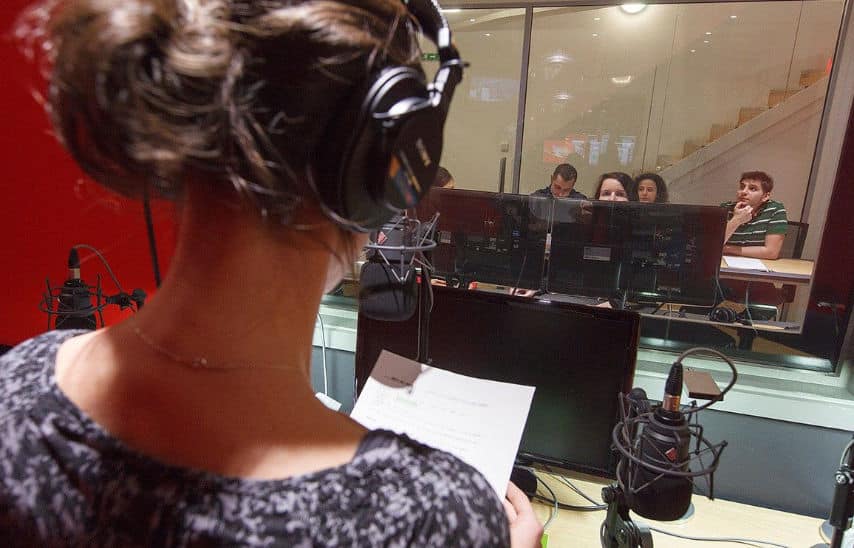Dubbing voice over a video is an art that transforms visual content into a universally understood language. In a world where connectivity knows no borders, the ability to convey your message seamlessly across cultures is paramount. This article, brought to you by GoLocalise, a prominent voice-over agency, will unravel the intricacies of dubbing and equip you with the skills to dub voice over a video like a seasoned professional.
In the age of digital media, your content has the potential to transcend geographical boundaries, captivating a global audience. Whether you’re a filmmaker, content creator, or business owner, the art of dubbing empowers you to convey your message effectively to diverse viewers.
Our mission with this article is to guide you through the fascinating world of dubbing, providing insights and expertise from GoLocalise, a leading voice-over agency. By the end of this journey, you will have gained valuable knowledge on how to dub voice over a video with precision and professionalism.
Throughout this article, we will explore the nuances of the dubbing process, from preparation to recording, editing, and dubbing into other languages. We’ll also address common questions and challenges, ensuring you are well-equipped to deliver high-quality dubbed content.
Join us on this exploration of the art of dubbing voice over a video, and discover the key to expanding your reach and making your content resonate with audiences worldwide.
Table of Contents
ToggleThe Art of Dubbing Voice Over a Video
ubbing voice over a video is a multifaceted art that breathes new life into visual content. At its core, dubbing involves the replacement of the original audio track of a video with a new one, often in a different language, while preserving the essence and spirit of the original.
Essence of Dubbing for Video Content
The essence of dubbing lies in its power to bridge linguistic and cultural divides, making content accessible and relatable to a global audience. It allows viewers from diverse backgrounds to connect with the storyline, characters, and emotions portrayed in the video. In essence, dubbing transcends language barriers, transforming a video into a universal form of expression.
Maintaining Tone and Emotion
One of the fundamental challenges in dubbing voice over a video is preserving the tone and emotion of the original performance. The effectiveness of dubbing hinges on the ability to convey the same depth of feeling and character as the source material. Whether it’s the warmth of a heartfelt conversation, the tension of an action scene, or the humor in a comedy, maintaining emotional authenticity is paramount.
Dubbing artists, therefore, play a pivotal role in capturing the nuances of the original performances. They must not only deliver lines accurately but also infuse them with the appropriate emotional weight. This requires a deep understanding of the characters, context, and cultural nuances, ensuring that viewers experience the same emotional journey as the original audience.
Importance of Quality in Dubbing
Quality is the cornerstone of successful dubbing. A well-executed dubbing process is virtually seamless, leaving viewers unaware that the audio has been altered. Conversely, a poorly dubbed video can become a distraction, detracting from the overall viewing experience.
Quality in dubbing encompasses various elements:
- Lip Sync: Ensuring that the dubbed audio matches the lip movements of the characters on screen is crucial. When the words spoken align perfectly with the characters’ mouth movements, the viewer’s immersion remains intact.
- Cultural Adaptation: Adapting the script to the target audience’s cultural context is essential. This involves not only translating words but also capturing cultural references, humor, and idioms to resonate with the local audience.
The art of dubbing voice over a video is a meticulous craft that goes beyond mere translation. It’s about conveying the heart and soul of the original content to a global audience while maintaining the integrity of the story and the emotions within. Quality is the bedrock of successful dubbing, and every aspect, from lip sync to cultural adaptation, plays a role in ensuring that the viewer’s experience is as authentic and captivating as the original.
Preparing for the Dubbing Process
Preparing for the dubbing process is a crucial phase that lays the foundation for a successful voice-over. To achieve a seamless and engaging dubbed video, several essential resources and considerations come into play.
Essential Resources for Successful Dubbing
- Original Video and Audio Files: The backbone of any dubbing project is the original video content and its associated audio. These source files provide the basis for dubbing, ensuring that the timing and visual cues align with the new voice-over.
- Script and Dialogue List: A comprehensive script and dialogue list are indispensable. These documents serve as a roadmap for the dubbing process, providing the translated lines and cues for voice actors to follow. The script is not just a translation; it’s a guide to capturing the essence of the original content.
- Character Sketches: Understanding the characters in the video is crucial. Character sketches offer insights into their personalities, quirks, and motivations. This knowledge helps voice actors deliver performances that resonate with the audience, staying true to the character’s essence.
- Original Cast Information: Knowledge about the original voice actors and their performances adds depth to the dubbing process. This insight enables the dubbing team to appreciate what made the original voices appealing and to aim for a similar connection with the audience.
- Technical Equipment: Dubbing requires specific technical equipment to ensure audio quality. A professional recording booth, microphones, soundproofing, and audio editing software are essential tools for achieving a clear and polished voice-over. Recording in a professional studio, such as GoLocalise’s state-of-the-art facilities, can greatly enhance the overall quality of the dub.
Understanding Characters and the Original Cast
Dubbing is not just about translating words; it’s about embodying characters and delivering performances that capture the essence of the original. Understanding the characters and the original cast’s performances is vital. This understanding allows voice actors to replicate the emotional depth, timing, and nuances of the original performances, ensuring that the dubbed voices feel authentic and relatable.
Importance of the Original Script and Dialogue List
The original script and dialogue list serve as the backbone of the dubbing process. They provide the translated lines and cues that voice actors need to match the original performances seamlessly. However, it’s essential to remember that dubbing isn’t a one-to-one translation; it’s about adapting the dialogue to resonate with the target audience while staying true to the original intent and emotions.
The Need for Technical Equipment
Technical equipment plays a significant role in ensuring the quality of the dub. A professional recording booth eliminates background noise, ensuring clean and clear audio recordings. High-quality microphones capture nuances in voice acting, while soundproofing prevents external disturbances. Advanced audio editing software allows for precise synchronisation of the dubbed audio with the video.
Recording in a professional recording studio, like GoLocalise, offers additional benefits. These studios are equipped with cutting-edge technology and experienced technicians who can optimise sound quality and provide guidance to voice actors, resulting in a professional and polished dub.
In short, preparing for the dubbing process involves gathering essential resources, understanding characters, having access to the original script, and ensuring the availability of technical equipment. These elements, when combined with the expertise of a professional dubbing team, set the stage for a successful voice-over that captivates audiences and maintains the integrity of the original content.
Recording Your Voice Over
Recording a voiceover is a pivotal stage in the dubbing process, where the spoken lines are brought to life with precision and artistry. To ensure a voiceover that resonates with the audience and maintains the integrity of the original content, several key considerations and steps come into play:
Steps Involved in Recording a Voiceover
- Preparation: Before stepping into the recording booth, it’s essential to thoroughly prepare. Familiarize yourself with the script, understand the character’s motivations and emotions, and rehearse the lines to ensure a natural delivery.
- Microphone Setup: Position the microphone correctly to capture the best audio quality. Adjust the distance and angle to avoid plosive sounds (such as ‘p’ and ‘b’ sounds) and minimize background noise.
- Soundproof Environment: Ensure that the recording environment is free from external noise and distractions. A soundproof recording booth or studio is ideal for achieving clean and professional audio.
- Take Direction: If you are working with a director or dubbing supervisor, be receptive to their guidance. They can provide valuable insights to help you deliver the desired performance.
- Multiple Takes: Be prepared to record multiple takes of each line. This allows for flexibility during the editing process and ensures that the best possible version is selected.
- Emotion and Timing: Pay close attention to the emotional nuances and timing of the original performance. Capturing the same emotional depth and rhythm is essential for a successful voiceover.
Advantages of Breaking the Recording into Smaller Sections
Breaking the recording into smaller sections offers several advantages:
- Accuracy: It allows for precise line delivery, ensuring that each line matches the original in terms of timing and emotion.
- Ease of Correction: If a mistake is made, it’s easier to re-record a smaller section than an entire scene. This minimizes the need for retakes and saves time.
- Consistency: Smaller sections promote consistency in performance. Voice actors can focus on perfecting each line, resulting in a more polished voiceover.
- Stamina: Recording for extended periods can strain the voice. Breaking the recording into smaller segments helps voice actors maintain vocal quality and energy throughout the session.
Emphasising the Importance of Taking Your Time
Achieving the desired voiceover quality requires patience and attention to detail. Rushing through the recording process can lead to subpar results. It’s essential to take your time to:
- Perfect Pronunciation: Ensure that every word is pronounced clearly and accurately. Clear pronunciation enhances the overall clarity of the voiceover.
- Emotional Authenticity: Focus on delivering the lines with genuine emotion and depth. Authenticity is key to connecting with the audience.
- Articulation: Pay attention to articulation and enunciation. Articulate speech ensures that every word is heard distinctly.
Tips for Recording High-Quality Voiceovers
To achieve high-quality voiceovers, consider the following tips:
- Stay Hydrated: Drink water to keep your vocal cords lubricated and prevent vocal strain.
- Warm-Up: Perform vocal warm-up exercises to prepare your voice for recording.
- Use Proper Breathing: Practice controlled breathing techniques to maintain consistent voice quality.
- Monitor Levels: Keep an eye on audio levels to prevent distortion or clipping.
- Express Emotion: Infuse emotion into your delivery to connect with the audience on an emotional level.
- Review and Adjust: After recording, review the takes and make necessary adjustments to achieve the desired quality.
Recording a voiceover is a meticulous process that demands preparation, attention to detail, and a commitment to delivering the desired quality. Breaking the recording into smaller sections, taking the time to perfect each line, and following best practices for high-quality voiceovers are essential steps in creating a voiceover that captivates and engages the audience.
Adding the Audio
After recording a flawless voiceover, the next crucial step is seamlessly integrating the recorded audio into the video. This process involves meticulous attention to detail to ensure that the final product not only sounds perfect but also looks professional. Here’s a detailed breakdown of adding the audio to your video:
Integrating the Recorded Audio into the Video
- Audio Editing Software: To start, import both the original video file and the recorded audio into audio editing software. Popular choices include Adobe Audition and Pro Tools, which allow for precise control over audio manipulation.
- Layering the Audio: Align the recorded voiceover with the video’s timeline. This often involves layering the new audio over the existing video, replacing the original spoken lines with the dubbed version.
- Synchronization: Ensure that the audio and video sync seamlessly. This requires precise timing to match the lip movements and actions of the on-screen characters. Accurate synchronization is crucial to maintain viewer immersion.
- Adjustment: Make any necessary adjustments to the volume, pitch, or pacing of the dubbed audio to achieve a natural and cohesive result. These adjustments ensure that the dubbed voice fits seamlessly into the video’s context.
Editing or Removing the Original Audio
In many cases, it’s essential to edit or remove the original audio from the video:
- Editing: If the original audio contains non-dialogue elements such as music or background noise, editing becomes necessary. This process involves removing or reducing unwanted sounds that may interfere with the dubbed voiceover.
- Voiceover Volume: Adjust the volume of the voiceover and original audio to create a balanced audio mix. The voiceover should take precedence without drowning out essential sound effects or music.
- Removing Original Dialogue: In situations where the original dialogue is not compatible with the dubbed voiceover, the original dialogue may need to be completely removed and replaced.
Seamless Synchronisation Between Audio and Video
Synchronisation between the dubbed audio and video is paramount for a professional result:
- Lip Sync: Achieving precise lip sync is an intricate task. Voice actors should match their speech to the on-screen character’s lip movements. This meticulous attention to detail ensures that viewers do not notice any disparity between the spoken words and mouth movements.
- Emotion and Timing: Beyond lip sync, synchronization extends to capturing the emotions and timing of the original performance. Each line delivery should evoke the same emotional depth and pacing as the source material.
- Background Sounds: Pay attention to the synchronisation of background sounds, such as footsteps or ambient noise, to maintain continuity.
Role of GoLocalise in Providing Audio Integration Solutions
GoLocalise, as a trusted voice-over agency, plays a crucial role in ensuring seamless audio integration. Their expertise extends beyond the recording studio, encompassing the entire dubbing process. Their professionals excel in:
- Precise Audio Editing: GoLocalise’s team can adeptly edit and integrate the recorded audio into your video with precision and attention to detail.
- Quality Assurance: They ensure that the final product meets the highest standards of audio and video synchronization, maintaining the integrity of the original content.
- Technical Excellence: GoLocalise’s state-of-the-art facilities and skilled technicians enable them to provide top-tier audio integration solutions that elevate the quality of the dub.
In summary, adding the audio to your video is a meticulous process that requires precise synchronisation, editing, and attention to detail. Achieving seamless integration between audio and video is essential to create a professional and engaging final product. With the support and expertise of GoLocalise, you can trust that your audio integration needs will be met with the utmost professionalism and quality.
Review and Finalise
Before presenting your dubbed video to the world, it’s imperative to undergo a comprehensive review process to ensure that every aspect aligns perfectly. This stage not only helps you identify any potential issues but also allows you to fine-tune the final product to perfection. Here’s an in-depth look at the importance of reviewing and finalizing your dubbed video:
Significance of Thorough Review
- Quality Assurance: Thoroughly reviewing the dubbed video is your last line of defense against any potential errors or inconsistencies. It ensures that the final product meets the highest standards of quality.
- Audience Experience: A well-reviewed video guarantees a smooth and immersive viewing experience for your audience. It helps maintain the integrity of the original content and enhances viewer satisfaction.
Making Necessary Alterations Based on the Review
- Identify Issues: During the review, carefully examine the video for any issues such as audio sync problems, volume inconsistencies, or visual artifacts. Pay attention to the subtleties of lip sync, emotional delivery, and overall coherence.
- Script Accuracy: Ensure that the translated script accurately conveys the original message while resonating with the target audience. Address any discrepancies or cultural nuances that may require adjustment.
- Editing: If issues are identified, be prepared to make the necessary edits. This may involve re-recording specific lines, adjusting audio levels, or fine-tuning the timing of the voiceover.
Importance of Multiple Rounds of Review and Adjustment
- Iterative Process: Dubbing is an iterative process. It’s rare to achieve perfection in a single review. Multiple rounds of review and adjustment allow you to refine the video further, making it even more polished and captivating.
- Collaboration: Collaborate with a team or professionals to gain diverse perspectives. A fresh set of eyes and ears can identify nuances and issues that may have been overlooked.
- Final Polish: Each round of review and adjustment brings the video closer to its final form. It’s an opportunity to fine-tune every aspect, ensuring that the voiceover, audio, and visuals work seamlessly together.
- Quality Control: The review process serves as a quality control mechanism. It allows you to catch and rectify any errors, no matter how minor, before the video is presented to the audience.
In summary, the review and finalisation stage is an indispensable part of the dubbing process. Thorough review ensures that your dubbed video is of the highest quality, maintaining the integrity of the original content while delivering a seamless and engaging viewer experience. Be prepared to make necessary alterations based on the review, and don’t hesitate to go through multiple rounds of review and adjustment to achieve a truly exceptional final product.
Dubbing the Voiceover into Other Languages
Expanding the reach of your video content beyond the borders of your native language is a strategic move in today’s globalized world. Dubbing the voiceover into other languages opens up opportunities to connect with diverse audiences and share your message on a global scale. However, this process requires careful consideration and expertise to avoid potential pitfalls. Here’s an in-depth exploration of dubbing voiceover into other languages:
The Need for Dubbing Voiceover into Other Languages
- Global Audience Reach: In a digitally connected world, content knows no boundaries. Dubbing your video into multiple languages allows you to tap into global markets and reach a more extensive and diverse audience.
- Accessibility: Dubbing makes your content accessible to non-English speakers, removing language barriers and ensuring that your message is understood and appreciated worldwide.
Potential Pitfalls of Poorly Executed Video Dubbing
- Comedic or Low-Quality Results: Poorly executed dubbing can lead to unintentional comedic effects or a perception of low quality. This can detract from the professionalism and impact of your video.
- Mismatched Cadence: If the cadence and timing of the dubbed audio do not match the original, it can create a jarring viewing experience and disconnect the audience from the content.
- Cultural Insensitivity: Improper translation or cultural insensitivity can alienate or offend audiences, damaging your brand’s reputation.
Options for Dubbing Videos
- Script Translation: Translating the original script into the desired language is a fundamental step. However, it’s not merely about word-for-word translation. A successful dub requires adaptation to the target audience’s culture and nuances. This ensures that the dubbed version resonates with viewers, similar to the original content.
- Hiring Voice Actors: Hiring native-speaking voice actors who are fluent in the target language is essential. These actors can bring authenticity and nuance to the dub, ensuring that the emotional depth and tone match the original.
- Synchronization: Achieving precise synchronization between the dubbed audio and the video is paramount. Lip-sync, timing, and emotional delivery should align seamlessly.
- Cultural Sensitivity: Pay attention to cultural references, humor, and context. Cultural adaptation ensures that your video remains relatable and culturally sensitive to the target audience.
GoLocalise’s Expertise in Multilingual Dubbing Services
GoLocalise, as a renowned voice-over agency, specializes in multilingual dubbing services. Their expertise extends to:
- Professional Script Adaptation: GoLocalise’s team excels in adapting scripts to ensure cultural relevance and emotional resonance, going beyond literal translations.
- Native-Speaking Voice Actors: They have access to a vast network of native-speaking voice actors who can deliver authentic and compelling performances in various languages.
- Synchronisation Excellence: GoLocalise’s technical proficiency ensures precise lip sync and audio-video alignment, enhancing the viewing experience.
- Cultural Nuance: Their team understands the importance of cultural sensitivity in dubbing, ensuring that your content remains respectful and engaging across cultures.
Dubbing voiceover into other languages is a strategic move to reach global audiences and break language barriers. However, it requires careful consideration and expertise to avoid pitfalls and ensure a seamless viewing experience. Options such as script translation, hiring native voice actors, synchronisation, and cultural sensitivity play pivotal roles in successful multilingual dubbing. GoLocalise’s extensive experience and commitment to excellence make them a trusted partner in achieving high-quality, multilingual dubbing solutions.
Frequently Asked Questions (FAQs)
What is the key to achieving high-quality dubbing for videos?
Achieving high-quality dubbing hinges on several factors, including script adaptation, voice actor selection, precise synchronization, and attention to cultural nuances. Working with professionals who understand the subtleties of language and emotion is essential. GoLocalise excels in these areas, ensuring exceptional dubbing quality.
Are there software tools that can simplify the dubbing process?
Yes, there are several software tools available for dubbing, from audio editing software for syncing to translation tools. However, while these tools can aid the process, they cannot replace the expertise of skilled professionals. GoLocalise combines industry-leading tools with human expertise to deliver superior dubbing solutions.
What challenges are involved in dubbing videos into multiple languages?
Dubbing into multiple languages presents challenges related to script adaptation, voice actor selection, and cultural relevance. Each language has unique linguistic and cultural nuances that must be considered. GoLocalise’s extensive network of native-speaking voice actors and cultural expertise ensures successful multilingual dubbing projects.
Can dubbing maintain the emotional impact of the original performance?
Yes, it’s possible to maintain the emotional impact of the original performance through skilled voice actors who understand the context and emotions of the content. GoLocalise’s voice actors are adept at preserving the emotional depth of the source material in their performances.
How long does the dubbing process typically take?
The duration of the dubbing process varies depending on factors such as video length, script complexity, and the number of languages involved. GoLocalise’s streamlined workflow and experienced team ensure efficient project management, reducing turnaround times.
Is it necessary to use professional dubbing services, or can I attempt dubbing in-house?
While in-house dubbing is possible, professional dubbing services offer several advantages, including access to skilled voice actors, precise synchronization, cultural expertise, and superior quality. GoLocalise’s expertise in voiceover and dubbing ensures exceptional results and saves you time and effort.
What languages does GoLocalise offer dubbing services in?
GoLocalise offers dubbing services in a wide range of languages, enabling you to reach diverse global audiences. Their network of native-speaking voice actors covers numerous languages, making them a versatile choice for multilingual dubbing projects.
Can GoLocalise help with script adaptation for dubbing into different languages?
Yes, GoLocalise excels in script adaptation, ensuring that the translated script maintains cultural relevance and emotional impact in the target language. Their expertise extends beyond literal translation to capture the essence of the original content.
What is the role of cultural sensitivity in dubbing?
Cultural sensitivity is crucial in dubbing to ensure that the content remains respectful and relatable to diverse audiences. GoLocalise’s team understands the importance of cultural nuances and adapts dubbing accordingly, preventing potential cultural missteps.
How can I get started with GoLocalise for my dubbing project?
To initiate your dubbing project with GoLocalise, simply reach out to their team to discuss your requirements. They offer a consultative approach to tailor their services to your specific needs, ensuring a successful dubbing experience.






















